When Bad Becomes Worse: Unethical Corporate Behavior May Hamper Consumer Acceptance of Cultured Meat
Abstract
:1. Introduction
1.1. Theoretical Background
1.2. Hypotheses and Theoretical Framework
1.3. Research Overview
2. Study 1
2.1. Materials and Methods
2.1.1. Participants
2.1.2. Materials and Measures
2.2. Results
2.2.1. Main Effects
2.2.2. Mediation Model
2.2.3. Moderated Mediation Model
2.3. Discussion of Study 1
3. Study 2
3.1. Materials and Methods
3.1.1. Participants
3.1.2. Materials and Measures
3.2. Results
3.2.1. Main Effects
3.2.2. Mediation Model
3.2.3. Moderated Mediation Model
3.3. Discussion of Study 2
4. General Discussion
5. Conclusions
Supplementary Materials
Author Contributions
Funding
Institutional Review Board Statement
Informed Consent Statement
Data Availability Statement
Acknowledgments
Conflicts of Interest
References
- Post, M.J. Cultured meat from stem cells: Challenges and prospects. Meat Sci. 2012, 92, 297–301. [Google Scholar] [CrossRef]
- Post, M.J.; Levenberg, S.; Kaplan, D.L.; Genovese, N.; Fu, J.; Bryant, C.; Negowetti, N.; Verzijden, K.; Moutsatsou, P. Scientific, sustainability and regulatory challenges of cultured meat. Nat. Food 2020, 1, 403–415. [Google Scholar] [CrossRef]
- Siegrist, M.; Hartmann, C. Consumer acceptance of novel food technologies. Nat. Food 2020, 1, 343–350. [Google Scholar] [CrossRef]
- Arshad, M.S.; Javed, M.; Sohaib, M.; Saeed, F.; Imran, A.; Amjad, Z. Tissue engineering approaches to develop cultured meat from cells: A mini review. Cogent Food Agric. 2017, 3. [Google Scholar] [CrossRef]
- Gaydhane, M.K.; Mahanta, U.; Sharma, C.S.; Khandelwal, M.; Ramakrishna, S. Cultured meat: State of the art and future. Biomanuf. Rev. 2018, 3, 1. [Google Scholar] [CrossRef]
- Post, M.; Hocquette, J.-F. New Sources of Animal Proteins: Cultured Meat. New Asp. Meat Qual. 2017, 16, 425–441. [Google Scholar] [CrossRef] [Green Version]
- Hocquette, J.-F. Is in vitro meat the solution for the future? Meat Sci. 2016, 120, 167–176. [Google Scholar] [CrossRef] [PubMed]
- Hopkins, P.D.; Dacey, A. Vegetarian Meat: Could Technology Save Animals and Satisfy Meat Eaters? J. Agric. Environ. Ethic 2008, 21, 579–596. [Google Scholar] [CrossRef]
- Lynch, J.; Pierrehumbert, R. Climate Impacts of Cultured Meat and Beef Cattle. Front. Sustain. Food Syst. 2019, 3. [Google Scholar] [CrossRef] [PubMed] [Green Version]
- Mattick, C.S.; Landis, A.E.; Allenby, B.R.; Genovese, N.J. Anticipatory Life Cycle Analysis of In Vitro Biomass Cultivation for Cultured Meat Production in the United States. Environ. Sci. Technol. 2015, 49, 11941–11949. [Google Scholar] [CrossRef]
- Tuomisto, H.L.; Ellis, M.J.; Haastrup, P. Environmental Impacts of Cultured Meat: Alternative Production Scenarios. In Proceedings of the 9th International Conference on Life Cycle Assessment in the Agri-Food Sector (LCA Food 2014), San Francisco, CA, USA, 8–10 October 2014. [Google Scholar]
- Boons, F.; Lüdeke-Freund, F. Business models for sustainable innovation: State-of-the-art and steps towards a research agenda. J. Clean. Prod. 2013, 45, 9–19. [Google Scholar] [CrossRef]
- Van der Weele, C.; Feindt, P.; van der Goot, A.J.; van Mierlo, B.; van Boekel, M. Meat alternatives: An integrative comparison. Trends Food Sci. Technol. 2019, 88, 505–512. [Google Scholar] [CrossRef]
- Oxford Martin School. WEF Alternative Proteins; Meat: The Future Series; WEF: Geneva, Switzerland, 2019; p. 32. [Google Scholar]
- Herrero, M.; Thornton, P.K.; Mason-D’Croz, D.; Palmer, J.; Benton, T.G.; Bodirsky, B.L.; Bogard, J.R.; Hall, A.; Lee, B.; Nyborg, K.; et al. Innovation can accelerate the transition towards a sustainable food system. Nat. Food 2020, 1, 266–272. [Google Scholar] [CrossRef]
- Allen, T.F.H.; Tainter, J.A.; Hoekstra, T.W. Supply-Side Sustainability. In Complexity in Ecological Systems; Columbia University Press: New York, NY, USA, 2003; Volume 16, pp. 403–427. [Google Scholar] [CrossRef]
- Creutzig, F.; Roy, J.; Lamb, W.F.; Azevedo, I.M.; De Bruin, W.B.; Dalkmann, H.; Edelenbosch, O.Y.; Geels, F.W.; Grubler, A.; Hepburn, C.; et al. Towards demand-side solutions for mitigating climate change. Nat. Clim. Chang. 2018, 8, 260–263. [Google Scholar] [CrossRef] [Green Version]
- Stephens, N.; Di Silvio, L.; Dunsford, I.; Ellis, M.; Glencross, A.; Sexton, A. Bringing cultured meat to market: Technical, socio-political, and regulatory challenges in cellular agriculture. Trends Food Sci. Technol. 2018, 78, 155–166. [Google Scholar] [CrossRef]
- Bryant, C.; Barnett, J. Consumer acceptance of cultured meat: A systematic review. Meat Sci. 2018, 143, 8–17. [Google Scholar] [CrossRef]
- Bryant, C.; Barnett, J. Consumer Acceptance of Cultured Meat: An Updated Review (2018–2020). Appl. Sci. 2020, 10, 5201. [Google Scholar] [CrossRef]
- Fernandes, A.M.; Teixeira, O.D.S.; Revillion, J.P.; de Souza Ângela, R.L. Panorama and ambiguities of cultured meat: An integrative approach. Crit. Rev. Food Sci. Nutr. 2021, 1–11. [Google Scholar] [CrossRef]
- Onwezen, M.; Bouwman, E.; Reinders, M.; Dagevos, H. A systematic review on consumer acceptance of alternative proteins: Pulses, algae, insects, plant-based meat alternatives, and cultured meat. Appetite 2021, 159, 105058. [Google Scholar] [CrossRef]
- Watson, E. The “World Is Watching” the Cell-Based Meat Industry. FoodNavigator-USA. 2019. Available online: https://www.foodnavigator-usa.com/Article/2019/02/11/The-world-is-watching-the-cell-based-meat-industry-says-Memphis-Meats-VP-Subpar-early-products-can-stigmatize-an-entire-category-for-decades-to-come (accessed on 27 June 2019).
- Mohorčich, J.; Reese, J. Cell-cultured meat: Lessons from GMO adoption and resistance. Appetite 2019, 143, 104408. [Google Scholar] [CrossRef]
- Rogers, E.M. Diffusion of Innovations, 5th ed.; Free Press: New York, NY, USA, 2003; ISBN 0743222091. [Google Scholar]
- Bryant, C.; Szejda, K.; Parekh, N.; Deshpande, V.; Tse, B. A Survey of Consumer Perceptions of Plant-Based and Clean Meat in the USA, India, and China. Front. Sustain. Food Syst. 2019, 3. [Google Scholar] [CrossRef]
- Slade, P. If you build it, will they eat it? Consumer preferences for plant-based and cultured meat burgers. Appetite 2018, 125, 428–437. [Google Scholar] [CrossRef] [PubMed]
- Verbeke, W.; Sans, P.; Van Loo, E.J. Challenges and prospects for consumer acceptance of cultured meat. J. Integr. Agric. 2015, 14, 285–294. [Google Scholar] [CrossRef]
- Wilks, M.; Phillips, C.J.; Fielding, K.; Hornsey, M.J. Testing potential psychological predictors of attitudes towards cultured meat. Appetite 2019, 136, 137–145. [Google Scholar] [CrossRef] [PubMed]
- Wilks, M.; Phillips, C.J.C. Attitudes to in vitro meat: A survey of potential consumers in the United States. PLoS ONE 2017, 12, e0171904. [Google Scholar] [CrossRef] [PubMed] [Green Version]
- Hwang, J.; You, J.; Moon, J.; Jeong, J. Factors Affecting Consumers’ Alternative Meats Buying Intentions: Plant-Based Meat Alternative and Cultured Meat. Sustainability 2020, 12, 5662. [Google Scholar] [CrossRef]
- Faccio, E.; Guiotto Nai Fovino, L. Food Neophobia or Distrust of Novelties? Exploring Consumers’ Attitudes toward GMOs, Insects and Cultured Meat. Appl. Sci. 2019, 9, 4440. [Google Scholar] [CrossRef] [Green Version]
- Siegrist, M.; Sütterlin, B. Importance of perceived naturalness for acceptance of food additives and cultured meat. Appetite 2017, 113, 320–326. [Google Scholar] [CrossRef]
- Siegrist, M.; Sütterlin, B.; Hartmann, C. Perceived naturalness and evoked disgust influence acceptance of cultured meat. Meat Sci. 2018, 139, 213–219. [Google Scholar] [CrossRef]
- Rolland, N.C.M.; Markus, C.R.; Post, M.J. The effect of information content on acceptance of cultured meat in a tasting context. PLoS ONE 2020, 15, e0231176. [Google Scholar] [CrossRef]
- Bekker, G.A.; Fischer, A.R.; Tobi, H.; van Trijp, H.C. Explicit and implicit attitude toward an emerging food technology: The case of cultured meat. Appetite 2017, 108, 245–254. [Google Scholar] [CrossRef]
- Bryant, C.; Dillard, C. The Impact of Framing on Acceptance of Cultured Meat. Front. Nutr. 2019, 6, 103. [Google Scholar] [CrossRef] [Green Version]
- Asioli, D.; Bazzani, C.; Nayga, R.M. Consumers’ valuation for lab produced meat: An investigation of naming effects. In Proceedings of the American Agricultural Economics Association (AAEA) Annual Meeting, Washington, DC, USA, 6–8 August 2018. [Google Scholar]
- Bryant, C.J.; Barnett, J.C. What’s in a name? Consumer perceptions of in vitro meat under different names. Appetite 2019, 137, 104–113. [Google Scholar] [CrossRef]
- GFI Clean Meat: The Naming of Tissue-Engineered Meat; Good Food Institute: Washington, WA, USA, 2016; Available online: https://gfi.org/blog/cultivatedmeat/ (accessed on 28 June 2019).
- GFI Cellular Agriculture Nomenclature: Optimizing Consumer Acceptance; Good Food Institute: Washington, WA, USA, 2018; Available online: https://gfi.org/images/uploads/2018/09/INN-RPT-Cellular-Agriculture-Nomenclature-2018-0921.pdf (accessed on 25 July 2019).
- GFI How We Talk about Meat Grown without Animals—Unpacking the Debate and the Data. Available online: https://www.gfi.org/how-we-talk-about-meat-grown-without-animals (accessed on 24 June 2019).
- Jo, A. Chris Bryant Messages to Overcome Naturalness Concerns in Clean Meat Acceptance: Primary Findings; Faunalytics: Olympia, WA, USA, 2018. [Google Scholar]
- Macdonald, B.; Vivalt, E. Effective Strategies for Overcoming the Naturalistic Heuristic: Experimental Evidence on Consumer Acceptance of “Clean” Meat; Open Science Framework: Charlottesville, VA, USA, 2017. [Google Scholar]
- Fernqvist, F.; Ekelund, L. Credence and the effect on consumer liking of food—A review. Food Qual. Prefer. 2014, 32, 340–353. [Google Scholar] [CrossRef] [Green Version]
- Schäufele, I.; Hamm, U. Consumers’ perceptions, preferences and willingness-to-pay for wine with sustainability characteristics: A review. J. Clean. Prod. 2017, 147, 379–394. [Google Scholar] [CrossRef]
- Fernqvist, F. Credence. Methods Consum. Res. 2018, 1, 531–555. [Google Scholar] [CrossRef]
- Poelman, A.; Mojet, J.; Lyon, D.; Sefa-Dedeh, S. The influence of information about organic production and fair trade on preferences for and perception of pineapple. Food Qual. Prefer. 2008, 19, 114–121. [Google Scholar] [CrossRef]
- Zanoli, R.; Scarpa, R.; Napolitano, F.; Piasentier, E.; Naspetti, S.; Bruschi, V. Organic label as an identifier of environmentally related quality: A consumer choice experiment on beef in Italy. Renew. Agric. Food Syst. 2012, 28, 70–79. [Google Scholar] [CrossRef] [Green Version]
- Wells, F.L. A Statistical Study of Literary Merit: With Remarks on Some New Phases of the Method. Arch. Psychol. 1907, 7, 5–30. [Google Scholar]
- Thorndike, E.L. A constant error in psychological ratings. J. Appl. Psychol. 1920, 4, 25–29. [Google Scholar] [CrossRef] [Green Version]
- Murphy, K.R.; Jako, R.A.; Anhalt, R.L. Nature and consequences of halo error: A critical analysis. J. Appl. Psychol. 1993, 78, 218–225. [Google Scholar] [CrossRef]
- Nisbett, R.E.; Wilson, T.D. The halo effect: Evidence for unconscious alteration of judgments. J. Pers. Soc. Psychol. 1977, 35, 250–256. [Google Scholar] [CrossRef]
- Talamas, S.N.; Mavor, K.I.; Perrett, D.I. Blinded by Beauty: Attractiveness Bias and Accurate Perceptions of Academic Performance. PLoS ONE 2016, 11, e0148284. [Google Scholar] [CrossRef] [PubMed] [Green Version]
- Forgas, J.P.; Laham, S.M.; Baumeister, R.; Vohs, K. Halo Effect. Encycl. Soc. Psychol. 2012, 1. [Google Scholar] [CrossRef]
- Petersen, M.; Brockhaus, S. Dancing in the dark: Challenges for product developers to improve and communicate product sustainability. J. Clean. Prod. 2017, 161, 345–354. [Google Scholar] [CrossRef]
- Ellison, B.; Duff, B.R.; Wang, Z.; White, T.B. Putting the organic label in context: Examining the interactions between the organic label, product type, and retail outlet. Food Qual. Prefer. 2016, 49, 140–150. [Google Scholar] [CrossRef] [Green Version]
- Schuldt, J.P.; Hannahan, M. When good deeds leave a bad taste. Negative inferences from ethical food claims. Appetite 2013, 62, 76–83. [Google Scholar] [CrossRef] [PubMed]
- Schuldt, J.P.; Muller, D.; Schwarz, N. The “Fair Trade” Effect. Soc. Psychol. Pers. Sci. 2012, 3, 581–589. [Google Scholar] [CrossRef] [Green Version]
- Chernev, A.; Blair, S. Doing Well by Doing Good: The Benevolent Halo of Corporate Social Responsibility. J. Consum. Res. 2015, 41, 1412–1425. [Google Scholar] [CrossRef]
- García-Torres, S.; López-Gajardo, A.; Mesías, F. Intensive vs. free-range organic beef. A preference study through consumer liking and conjoint analysis. Meat Sci. 2016, 114, 114–120. [Google Scholar] [CrossRef] [PubMed]
- Napolitano, F.; Braghieri, A.; Piasentier, E.; Favotto, S.; Naspetti, S.; Zanoli, R. Effect of information about organic production on beef liking and consumer willingness to pay. Food Qual. Prefer. 2010, 21, 207–212. [Google Scholar] [CrossRef] [Green Version]
- Napolitano, F.; Castellini, C.; Naspetti, S.; Piasentier, E.; Girolami, A.; Braghieri, A. Consumer preference for chicken breast may be more affected by information on organic production than by product sensory properties. Poult. Sci. 2013, 92, 820–826. [Google Scholar] [CrossRef] [PubMed]
- Anderson, E.C.; Barrett, L.F. Affective Beliefs Influence the Experience of Eating Meat. PLoS ONE 2016, 11, e0160424. [Google Scholar] [CrossRef] [PubMed]
- Aguinis, H.; Glavas, A. What We Know and Don’t Know About Corporate Social Responsibility. J. Manag. 2012, 38, 932–968. [Google Scholar] [CrossRef] [Green Version]
- Wilcock, A.; Pun, M.; Khanona, J.; Aung, M. Consumer attitudes, knowledge and behaviour: A review of food safety issues. Trends Food Sci. Technol. 2004, 15, 56–66. [Google Scholar] [CrossRef]
- Barlow, S.M.; Boobis, A.R.; Bridges, J.; Cockburn, A.; Dekant, W.; Hepburn, P.; Houben, G.F.; Koenig, J.; Nauta, M.J.; Schuermans, J.; et al. The role of hazard- and risk-based approaches in ensuring food safety. Trends Food Sci. Technol. 2015, 46, 176–188. [Google Scholar] [CrossRef] [Green Version]
- Behrens, J.H.; Barcellos, M.N.; Frewer, L.J.; Nunes, T.; Franco, B.D.; Destro, M.T.; Landgraf, M. Consumer purchase habits and views on food safety: A Brazilian study. Food Control. 2010, 21, 963–969. [Google Scholar] [CrossRef]
- Ergönül, B. Consumer awareness and perception to food safety: A consumer analysis. Food Control. 2013, 32, 461–471. [Google Scholar] [CrossRef]
- Turner, M.; Kitchenham, B.; Brereton, P.; Charters, S.; Budgen, D. Does the technology acceptance model predict actual use? A systematic literature review. Inf. Softw. Technol. 2010, 52, 463–479. [Google Scholar] [CrossRef]
- Fischer, A.R.; Reinders, M. Consumer Acceptance of Novel Foods. In Innovation Strategies in the Food Industry; Elsevier: Amsterdam, The Netherlands, 2016; pp. 271–292. [Google Scholar]
- Grankvist, G.; Lekedal, H.; Marmendal, M. Values and eco- and fair-trade labelled products. Br. Food J. 2007, 109, 169–181. [Google Scholar] [CrossRef]
- Sörqvist, P.; Hedblom, D.; Holmgren, M.; Haga, A.; Langeborg, L.; Nöstl, A.; Kågström, J. Who Needs Cream and Sugar When There Is Eco-Labeling? Taste and Willingness to Pay for “Eco-Friendly” Coffee. PLoS ONE 2013, 8, e80719. [Google Scholar] [CrossRef]
- Hüffmeier, J.; Mazei, J.; Schultze, T. Reconceptualizing replication as a sequence of different studies: A replication typology. J. Exp. Soc. Psychol. 2016, 66, 81–92. [Google Scholar] [CrossRef]
- Hayes, A.F. Introduction to Mediation, Moderation, and Conditional Process Analysis: A Regression-Based Approach, 2nd ed.; Methodology in the Social Sciences; Guilford Press: New York, NY, USA, 2018; ISBN 978-1-4625-3465-4. [Google Scholar]
- Krishna, A. A clearer spotlight on spotlight: Understanding, conducting and reporting. J. Consum. Psychol. 2016, 26, 315–324. [Google Scholar] [CrossRef]
- Faul, F.; Erdfelder, E.; Buchner, A.; Lang, A.-G. Statistical power analyses using G*Power 3.1: Tests for correlation and regression analyses. Behav. Res. Methods 2009, 41, 1149–1160. [Google Scholar] [CrossRef] [Green Version]
- Faul, F.; Erdfelder, E.; Lang, A.-G.; Buchner, A. G*Power 3: A flexible statistical power analysis program for the social, behavioral, and biomedical sciences. Behav. Res. Methods 2007, 39, 175–191. [Google Scholar] [CrossRef]
- Cohen, J. A power primer. Psychol. Bull. 1992, 112, 155–159. [Google Scholar] [CrossRef]
- Buhrmester, M.D.; Talaifar, S.; Gosling, S.D. An Evaluation of Amazon’s Mechanical Turk, Its Rapid Rise, and Its Effective Use. Perspect. Psychol. Sci. 2018, 13, 149–154. [Google Scholar] [CrossRef] [PubMed]
- Buhrmester, M.D.; Kwang, T.; Gosling, S.D. Amazon’s Mechanical Turk. Perspect. Psychol. Sci. 2011, 6, 3–5. [Google Scholar] [CrossRef] [PubMed]
- Kees, J.; Berry, C.; Burton, S.; Sheehan, K. An Analysis of Data Quality: Professional Panels, Student Subject Pools, and Amazon’s Mechanical Turk. J. Advert. 2017, 46, 141–155. [Google Scholar] [CrossRef]
- Mason, W.; Suri, S. Conducting behavioral research on Amazon’s Mechanical Turk. Behav. Res. Methods 2012, 44, 1–23. [Google Scholar] [CrossRef] [PubMed]
- Rouse, S.V. A reliability analysis of Mechanical Turk data. Comput. Hum. Behav. 2015, 43, 304–307. [Google Scholar] [CrossRef]
- Goldstone, A.P.; De Hernandez, C.G.P.; Beaver, J.D.; Muhammed, K.; Croese, C.; Bell, G.; Durighel, G.; Hughes, E.; Waldman, A.D.; Frost, G.; et al. Fasting biases brain reward systems towards high-calorie foods. Eur. J. Neurosci. 2009, 30, 1625–1635. [Google Scholar] [CrossRef] [PubMed]
- Wren, A.M.; Seal, L.J.; Cohen, M.A.; Brynes, A.E.; Frost, G.S.; Murphy, K.G.; Dhillo, W.; Ghatei, M.A.; Bloom, S.R. Ghrelin Enhances Appetite and Increases Food Intake in Humans. J. Clin. Endocrinol. Metab. 2001, 86, 5992. [Google Scholar] [CrossRef] [PubMed]
- Piazza, J.R.; Loughnan, S. When Meat Gets Personal, Animals’ Minds Matter Less. Soc. Psychol. Pers. Sci. 2016, 7, 867–874. [Google Scholar] [CrossRef] [Green Version]
- Piazza, J.; Ruby, M.B.; Loughnan, S.; Luong, M.; Kulik, J.; Watkins, H.M.; Seigerman, M. Rationalizing meat consumption. The 4Ns. Appetite 2015, 91, 114–128. [Google Scholar] [CrossRef] [Green Version]
- Graham, J.; Haidt, J.; Nosek, B.A. Liberals and conservatives rely on different sets of moral foundations. J. Pers. Soc. Psychol. 2009, 96, 1029–1046. [Google Scholar] [CrossRef]
- Simmons, J.P.; Nelson, L.D.; Simonsohn, U. False-Positive Psychology. Psychol. Sci. 2011, 22, 1359–1366. [Google Scholar] [CrossRef] [PubMed] [Green Version]
- Pliner, P.; Hobden, K.L. Development of a scale to measure the trait of food neophobia in humans. Appetite 1992, 19, 105–120. [Google Scholar] [CrossRef]
- MacKinnon, D.P.; Krull, J.L.; Lockwood, C.M. Equivalence of the Mediation, Confounding and Suppression Effect. Prev. Sci. 2000, 1, 173–181. [Google Scholar] [CrossRef] [PubMed]
- Baumeister, R.F.; Bratslavsky, E.; Finkenauer, C.; Vohs, K.D. Bad is Stronger than Good. Rev. Gen. Psychol. 2001, 5, 323–370. [Google Scholar] [CrossRef]
- Ito, T.A.; Larsen, J.T.; Smith, N.K.; Cacioppo, J.T. Negative information weighs more heavily on the brain: The negativity bias in evaluative categorizations. J. Pers. Soc. Psychol. 1998, 75, 887–900. [Google Scholar] [CrossRef]
- Rozin, P.; Royzman, E.B. Negativity Bias, Negativity Dominance, and Contagion. Pers. Soc. Psychol. Rev. 2001, 5, 296–320. [Google Scholar] [CrossRef]
- Kahneman, D.; Tversky, A. Prospect theory: An analysis of decision under risk. Econometrica 1979, 47, 263–292. [Google Scholar] [CrossRef] [Green Version]
- Tversky, A.; Kahneman, D. Advances in prospect theory: Cumulative representation of uncertainty. J. Risk Uncertain. 1992, 5, 297–323. [Google Scholar] [CrossRef]
- Roe, B.; Teisl, M.F. Genetically modified food labeling: The impacts of message and messenger on consumer perceptions of labels and products. Food Policy 2007, 32, 49–66. [Google Scholar] [CrossRef]
- Siegrist, M.; Cvetkovich, G. Better Negative than Positive? Evidence of a Bias for Negative Information about Possible Health Dangers. Risk Anal. 2001, 21, 199–206. [Google Scholar] [CrossRef]
- Guan, X.; Lei, Q.; Yan, Q.; Li, X.; Zhou, J.; Du, G.; Chen, J. Trends and ideas in technology, regulation and public acceptance of cultured meat. Futur. Foods 2021, 3, 100032. [Google Scholar] [CrossRef]
- Mancini, M.C.; Antonioli, F. Exploring consumers’ attitude towards cultured meat in Italy. Meat Sci. 2019, 150, 101–110. [Google Scholar] [CrossRef] [PubMed]
- Pino, G.; Amatulli, C.; De Angelis, M.; Peluso, A.M. The influence of corporate social responsibility on consumers’ attitudes and intentions toward genetically modified foods: Evidence from Italy. J. Clean. Prod. 2016, 112, 2861–2869. [Google Scholar] [CrossRef]
- Cooper, W.H. Ubiquitous halo. Psychol. Bull. 1981, 90, 218–244. [Google Scholar] [CrossRef]
- Cavaliere, A.; Ventura, V. Mismatch between food sustainability and consumer acceptance toward innovation technologies among Millennial students: The case of Shelf Life Extension. J. Clean. Prod. 2018, 175, 641–650. [Google Scholar] [CrossRef]
- Cox, D.; Evans, G. Construction and validation of a psychometric scale to measure consumers’ fears of novel food technologies: The food technology neophobia scale. Food Qual. Preference 2008, 19, 704–710. [Google Scholar] [CrossRef]
- Surveygoo Nearly One in Three Consumers Willing to Eat Lab-Grown Meat, According to New Research. Available online: https://www.datasmoothie.com/@surveygoo/nearly-one-in-three-consumers-willing-to-eat-lab-g/ (accessed on 24 June 2019).
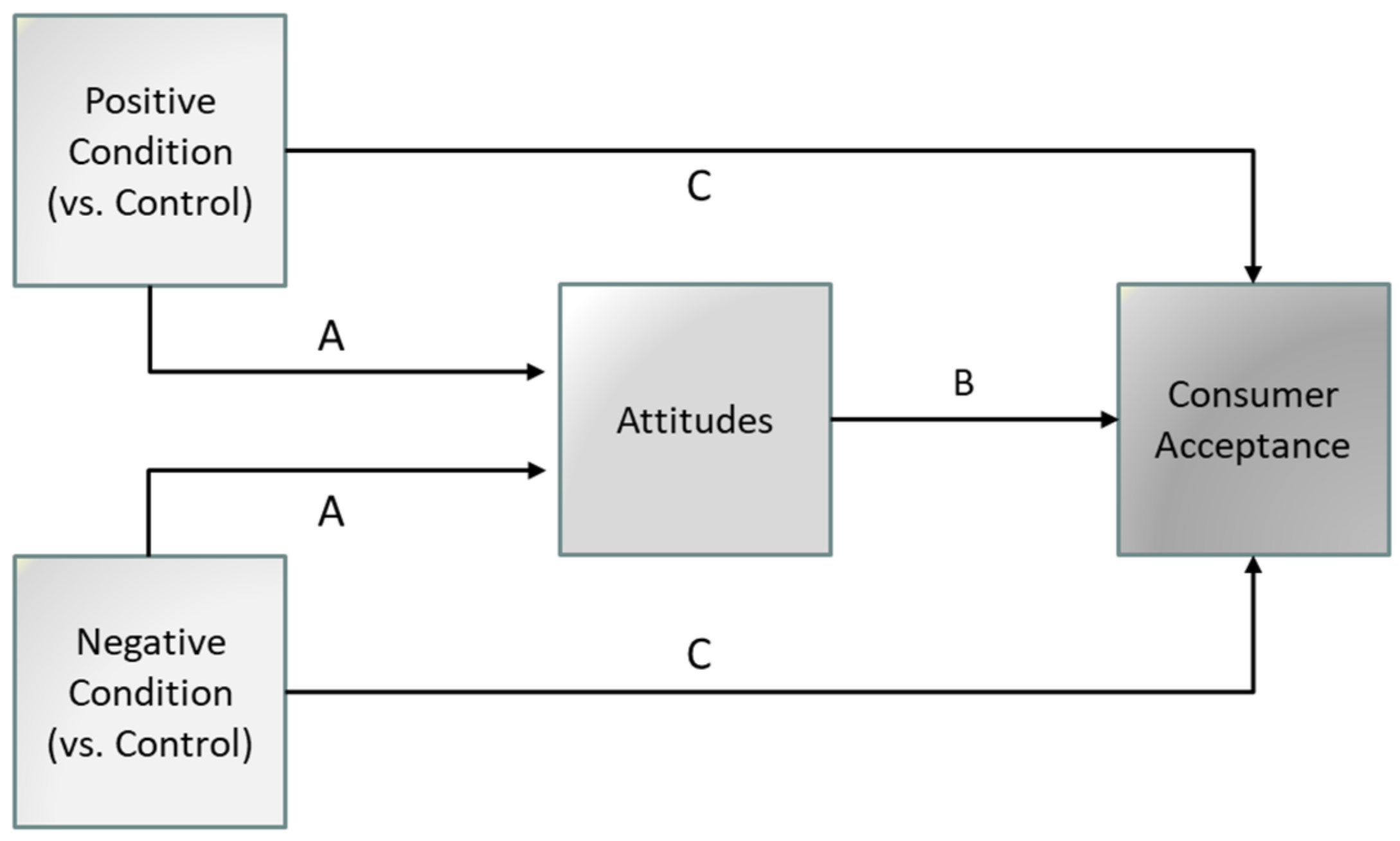
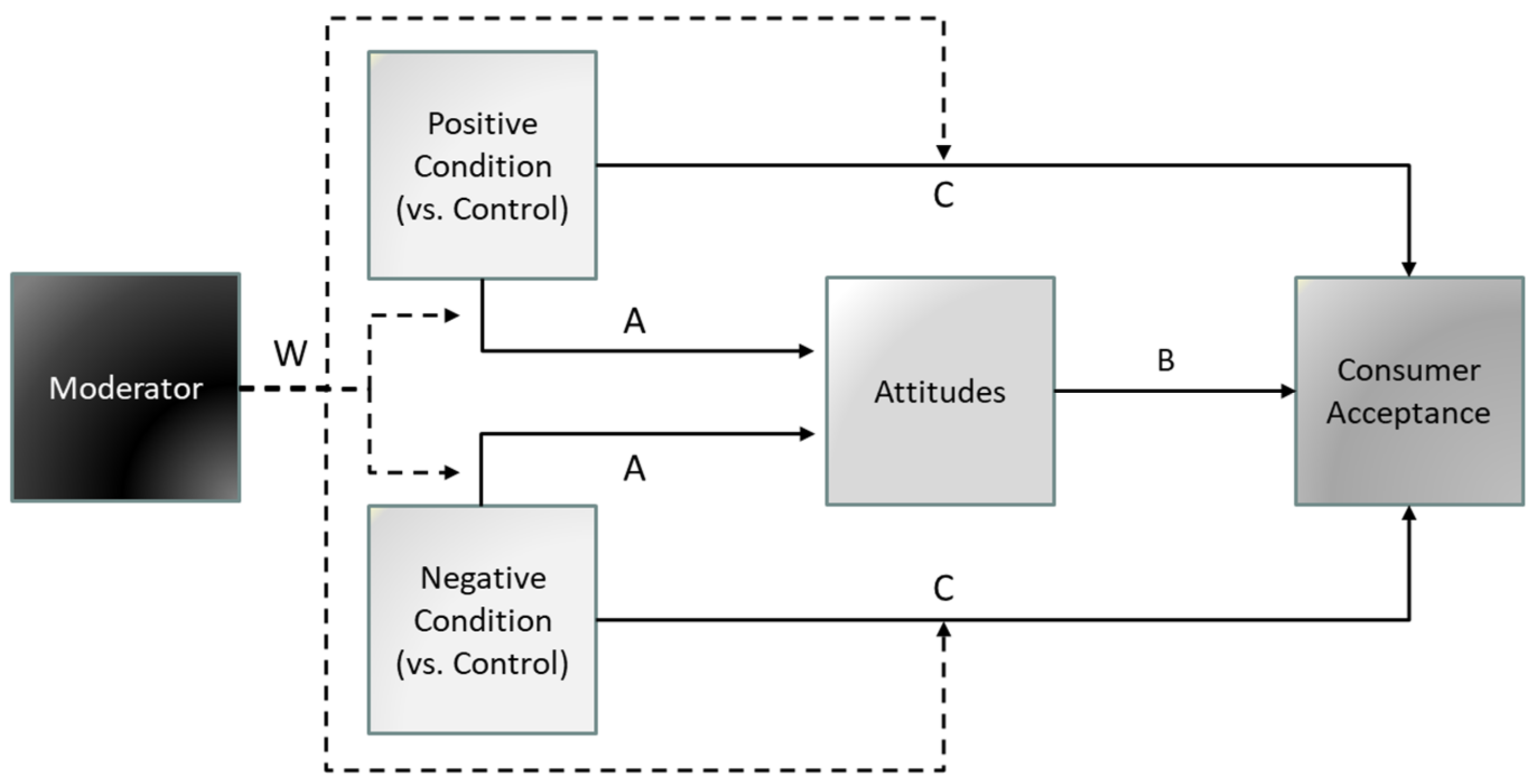
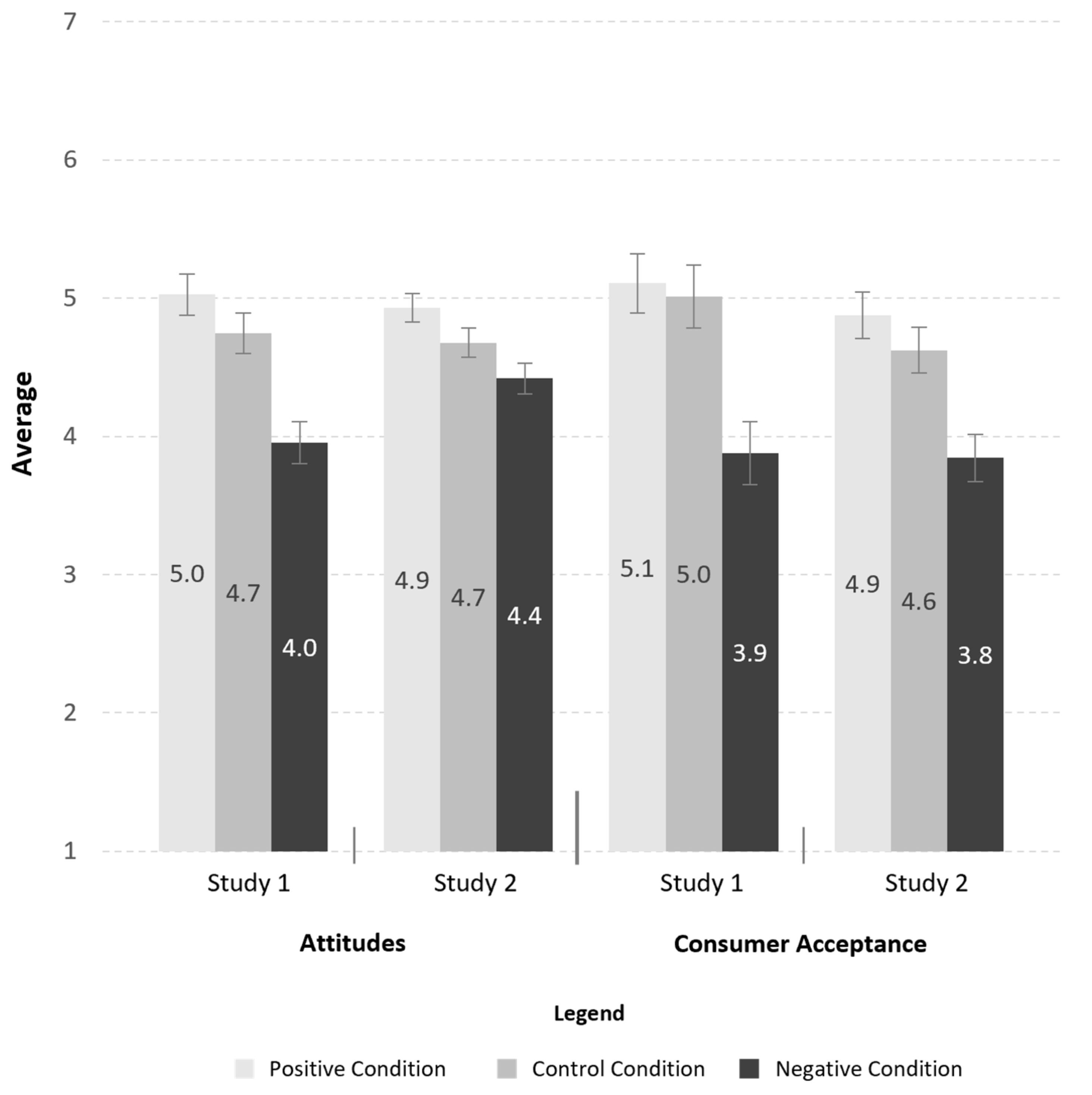
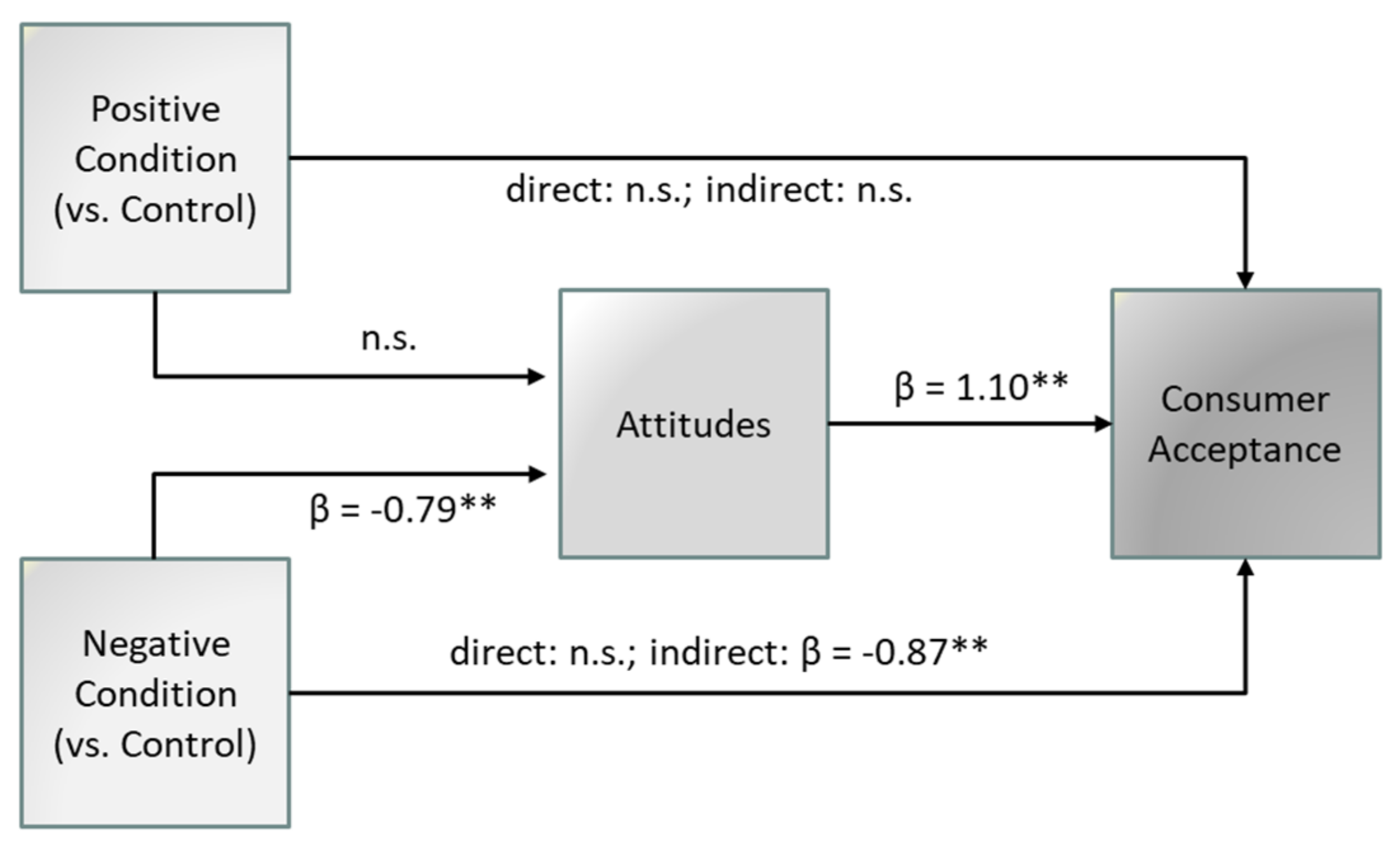
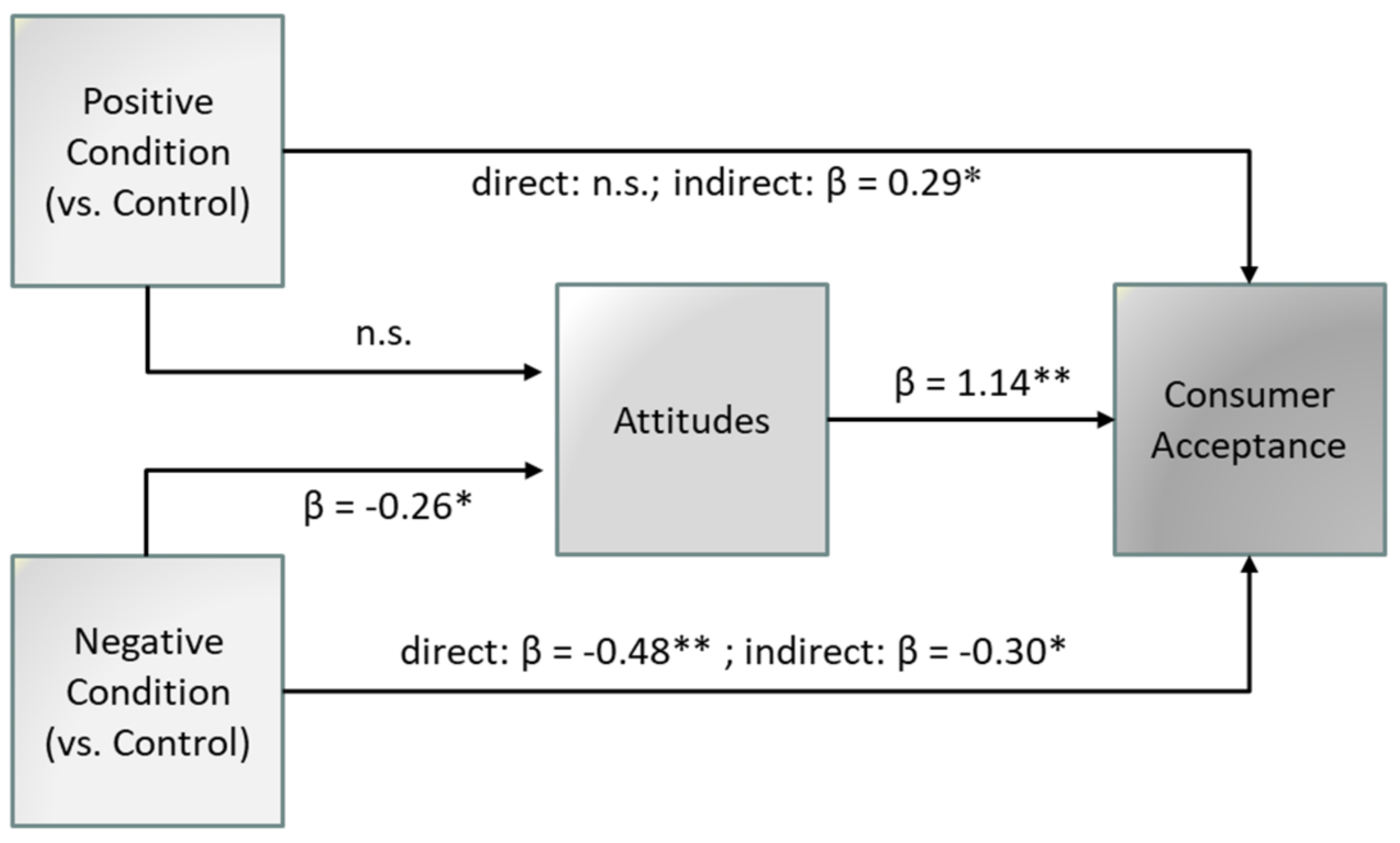
Publisher’s Note: MDPI stays neutral with regard to jurisdictional claims in published maps and institutional affiliations. |
© 2021 by the authors. Licensee MDPI, Basel, Switzerland. This article is an open access article distributed under the terms and conditions of the Creative Commons Attribution (CC BY) license (https://creativecommons.org/licenses/by/4.0/).
Share and Cite
Rabl, V.A.; Basso, F. When Bad Becomes Worse: Unethical Corporate Behavior May Hamper Consumer Acceptance of Cultured Meat. Sustainability 2021, 13, 6770. https://doi.org/10.3390/su13126770
Rabl VA, Basso F. When Bad Becomes Worse: Unethical Corporate Behavior May Hamper Consumer Acceptance of Cultured Meat. Sustainability. 2021; 13(12):6770. https://doi.org/10.3390/su13126770
Chicago/Turabian StyleRabl, Vincent A., and Frédéric Basso. 2021. "When Bad Becomes Worse: Unethical Corporate Behavior May Hamper Consumer Acceptance of Cultured Meat" Sustainability 13, no. 12: 6770. https://doi.org/10.3390/su13126770
APA StyleRabl, V. A., & Basso, F. (2021). When Bad Becomes Worse: Unethical Corporate Behavior May Hamper Consumer Acceptance of Cultured Meat. Sustainability, 13(12), 6770. https://doi.org/10.3390/su13126770





